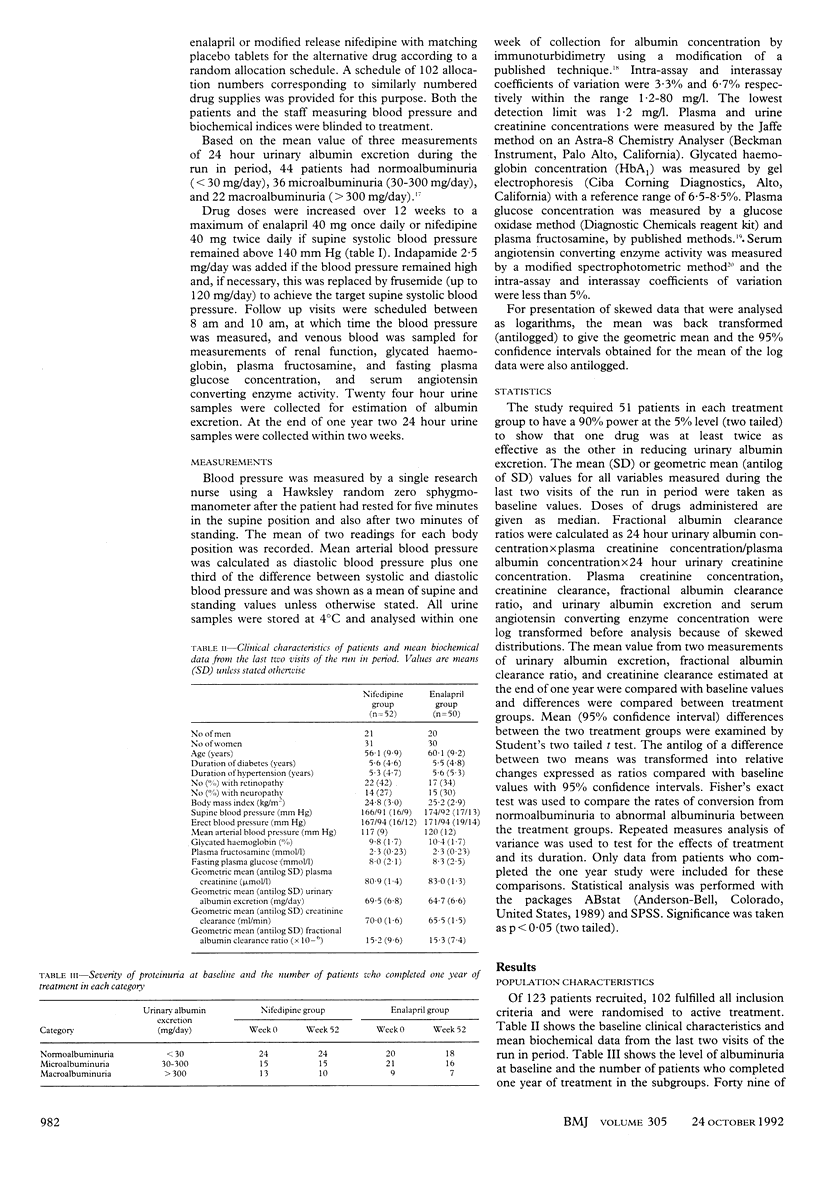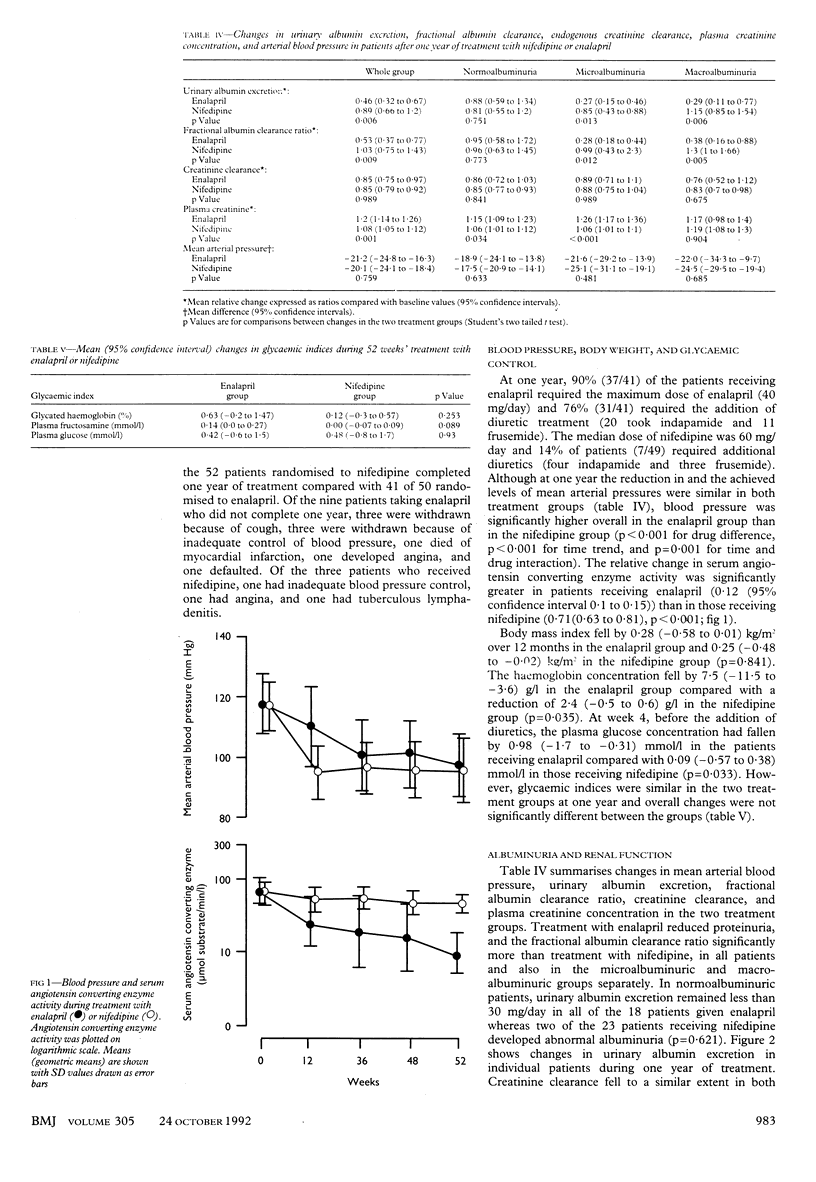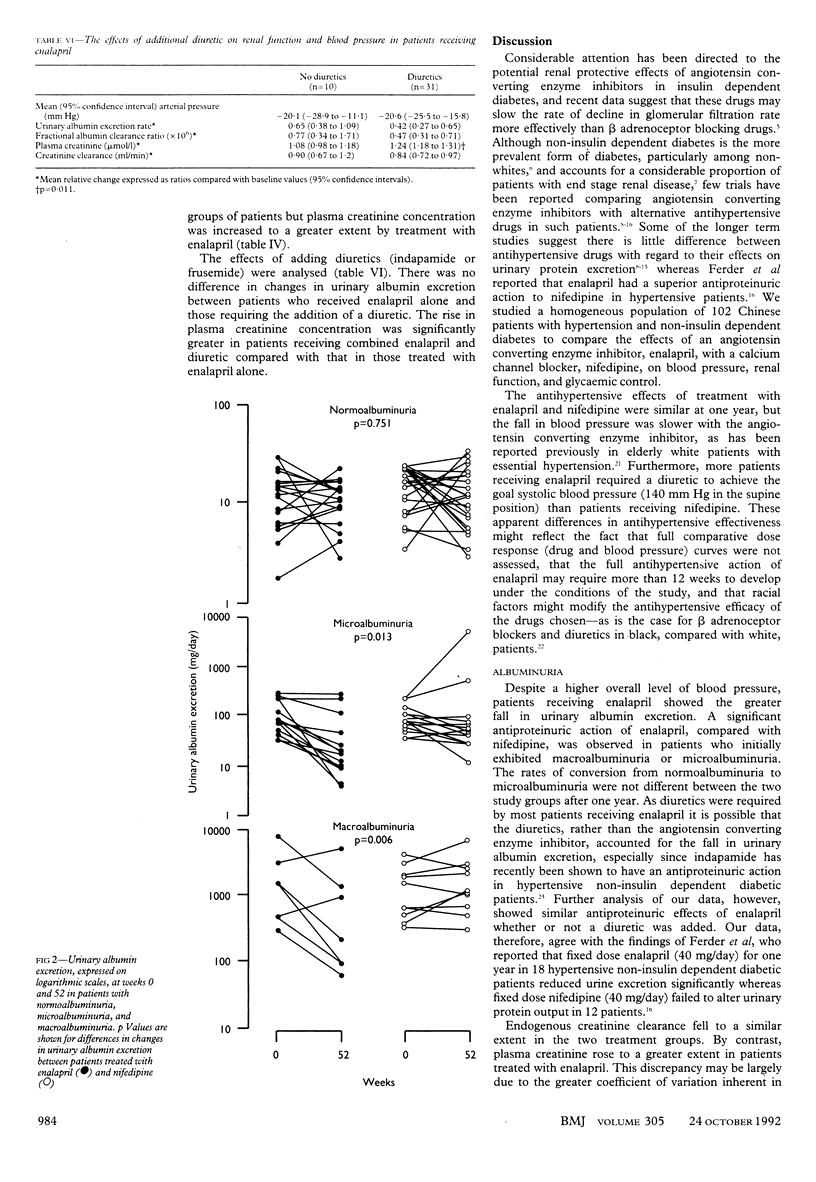Abstract
OBJECTIVES--To compare the efficacy, safety, and tolerance of enalapril and nifedipine in hypertensive patients with non-insulin dependent diabetes. DESIGN--One year double blind follow up of patients randomly allocated to either enalapril or nifedipine with matching placebos for the alternative drug. SETTING--Metabolic Investigation Unit, Hong Kong. SUBJECTS--102 patients were randomised: 52 to nifedipine and 50 to enalapril. At baseline 44 patients had normoalbuminuria, 36 microalbuminuria, and 22 macroalbuminuria. MAIN OUTCOME MEASURES--Blood pressure, albuminuria, and parameters of renal function and glycaemic control. RESULTS--In patients who completed one year's treatment the median dose required by the nifedipine group (n = 49) was 60 mg/day; seven (14%) required additional diuretics. Of 41 patients given enalapril, 37 required the maximum dose (40 mg/day) and 27 (76%) required diuretics. At one year mean arterial blood pressures were similar in both groups. Albuminuria fell by 54% in the enalapril group and 11% in the nifedipine group (p = 0.006). Fractional albumin clearance ratio fell by 47% in the enalapril group and increased by 3% in the nifedipine group (p = 0.009). Creatinine clearance fell similarly in both groups but plasma creatinine concentration was increased by 20% in the enalapril group versus 8% in the nifedipine group (p = 0.001). CONCLUSION--Patients taking enalapril often required diuretics to control blood pressure. Enalapril reduced proteinuria significantly more than nifedipine in the microalbuminuric and macroalbuminuric patients but increased plasma creatinine concentrations. Longer follow up is required to clarify the importance of enalapril's antiproteinuric effect.
Full text
PDF




Selected References
These references are in PubMed. This may not be the complete list of references from this article.
- Arauz-Pacheco C., Ramirez L. C., Rios J. M., Raskin P. Hypoglycemia induced by angiotensin-converting enzyme inhibitors in patients with non-insulin-dependent diabetes receiving sulfonylurea therapy. Am J Med. 1990 Dec;89(6):811–813. doi: 10.1016/0002-9343(90)90227-5. [DOI] [PubMed] [Google Scholar]
- Baba T., Murabayashi S., Takebe K. Comparison of the renal effects of angiotensin converting enzyme inhibitor and calcium antagonist in hypertensive type 2 (non-insulin-dependent) diabetic patients with microalbuminuria: a randomised controlled trial. Diabetologia. 1989 Jan;32(1):40–44. doi: 10.1007/BF00265402. [DOI] [PubMed] [Google Scholar]
- Björck S., Mulec H., Johnsen S. A., Nordén G., Aurell M. Renal protective effect of enalapril in diabetic nephropathy. BMJ. 1992 Feb 8;304(6823):339–343. doi: 10.1136/bmj.304.6823.339. [DOI] [PMC free article] [PubMed] [Google Scholar]
- Chan J. C., Cockram C. S. Drug-induced disturbances of carbohydrate metabolism. Adverse Drug React Toxicol Rev. 1991 Spring;10(1):1–29. [PubMed] [Google Scholar]
- Cheung C. K., Swaminathan R. Automated immunoturbidimetric methods for the determination of retinol binding protein, prealbumin and transferrin in urine. Clin Biochem. 1989 Dec;22(6):425–427. doi: 10.1016/s0009-9120(89)80092-x. [DOI] [PubMed] [Google Scholar]
- Ferriere M., Lachkar H., Richard J. L., Bringer J., Orsetti A., Mirouze J. Captopril and insulin sensitivity. Ann Intern Med. 1985 Jan;102(1):134–135. doi: 10.7326/0003-4819-102-1-134_3. [DOI] [PubMed] [Google Scholar]
- Gambardella S., Frontoni S., Lala A., Felici M. G., Spallone V., Scoppola A., Jacoangeli F., Menzinger G. Regression of microalbuminuria in type II diabetic, hypertensive patients after long-term indapamide treatment. Am Heart J. 1991 Oct;122(4 Pt 2):1232–1238. doi: 10.1016/0002-8703(91)90946-f. [DOI] [PubMed] [Google Scholar]
- Heller J., Horácek V. Angiotensin II: preferential efferent constriction? Ren Physiol. 1986;9(6):357–365. doi: 10.1159/000173101. [DOI] [PubMed] [Google Scholar]
- Jauch K. W., Hartl W., Guenther B., Wicklmayr M., Rett K., Dietze G. Captopril enhances insulin responsiveness of forearm muscle tissue in non-insulin-dependent diabetes mellitus. Eur J Clin Invest. 1987 Oct;17(5):448–454. doi: 10.1111/j.1365-2362.1987.tb01141.x. [DOI] [PubMed] [Google Scholar]
- Kamper A. L., Nielsen O. J. Effect of enalapril on haemoglobin and serum erythropoietin in patients with chronic nephropathy. Scand J Clin Lab Invest. 1990 Oct;50(6):611–618. doi: 10.3109/00365519009089178. [DOI] [PubMed] [Google Scholar]
- MacDonald D., Pang C. P., Cockram C. S., Swaminathan R. Fructosamine measurements in serum and plasma. Clin Chim Acta. 1987 Sep 30;168(2):247–252. doi: 10.1016/0009-8981(87)90294-4. [DOI] [PubMed] [Google Scholar]
- Maguire G. A., Price C. P. A continuous monitoring spectrophotometric method for the measurement of angiotensin-converting enzyme in human serum. Ann Clin Biochem. 1985 Mar;22(Pt 2):204–210. doi: 10.1177/000456328502200218. [DOI] [PubMed] [Google Scholar]
- Matthews D. M., Wathen C. G., Bell D., Collier A., Roulston J. E., Clarke B. F., Muir A. L. The use of captopril and captopril plus frusemide as antihypertensive agents in non-insulin dependent diabetes. J Hum Hypertens. 1987 Jun;1(1):19–23. [PubMed] [Google Scholar]
- Mogensen C. E. Angiotensin converting enzyme inhibitors and diabetic nephropathy. BMJ. 1992 Feb 8;304(6823):327–328. doi: 10.1136/bmj.304.6823.327. [DOI] [PMC free article] [PubMed] [Google Scholar]
- Mujais S. K., Fouad F. M., Textor S. C., Tarazi R. C., Bravo E. L., Hart N., Gifford R. W., Jr Transient renal dysfunction during initial inhibition of converting enzyme in congestive heart failure. Br Heart J. 1984 Jul;52(1):63–71. doi: 10.1136/hrt.52.1.63. [DOI] [PMC free article] [PubMed] [Google Scholar]
- Payne R. B. Creatinine clearance: a redundant clinical investigation. Ann Clin Biochem. 1986 May;23(Pt 3):243–250. doi: 10.1177/000456328602300304. [DOI] [PubMed] [Google Scholar]
- Pollare T., Lithell H., Berne C. A comparison of the effects of hydrochlorothiazide and captopril on glucose and lipid metabolism in patients with hypertension. N Engl J Med. 1989 Sep 28;321(13):868–873. doi: 10.1056/NEJM198909283211305. [DOI] [PubMed] [Google Scholar]
- Rowe D. J., Dawnay A., Watts G. F. Microalbuminuria in diabetes mellitus: review and recommendations for the measurement of albumin in urine. Ann Clin Biochem. 1990 Jul;27(Pt 4):297–312. doi: 10.1177/000456329002700404. [DOI] [PubMed] [Google Scholar]
- Stornello M., Valvo E. V., Scapellato L. Persistent albuminuria in normotensive non-insulin-dependent (type II) diabetic patients: comparative effects of angiotensin-converting enzyme inhibitors and beta-adrenoceptor blockers. Clin Sci (Lond) 1992 Jan;82(1):19–23. doi: 10.1042/cs0820019. [DOI] [PubMed] [Google Scholar]
- Ueda Y., Aoi W., Yamachika S., Shikaya T. Beneficial effects of angiotensin-converting enzyme inhibitor on renal function and glucose homeostasis in diabetics with hypertension. Nephron. 1990;55 (Suppl 1):85–89. doi: 10.1159/000186043. [DOI] [PubMed] [Google Scholar]
- Valvo E., Bedogna V., Casagrande P., Antiga L., Zamboni M., Bommartini F., Oldrizzi L., Rugiu C., Maschio G. Captopril in patients with type II diabetes and renal insufficiency: systemic and renal hemodynamic alterations. Am J Med. 1988 Sep;85(3):344–348. doi: 10.1016/0002-9343(88)90584-0. [DOI] [PubMed] [Google Scholar]
- Zimmet P. Type 2 (non-insulin-dependent) diabetes--an epidemiological overview. Diabetologia. 1982 Jun;22(6):399–411. doi: 10.1007/BF00282581. [DOI] [PubMed] [Google Scholar]


